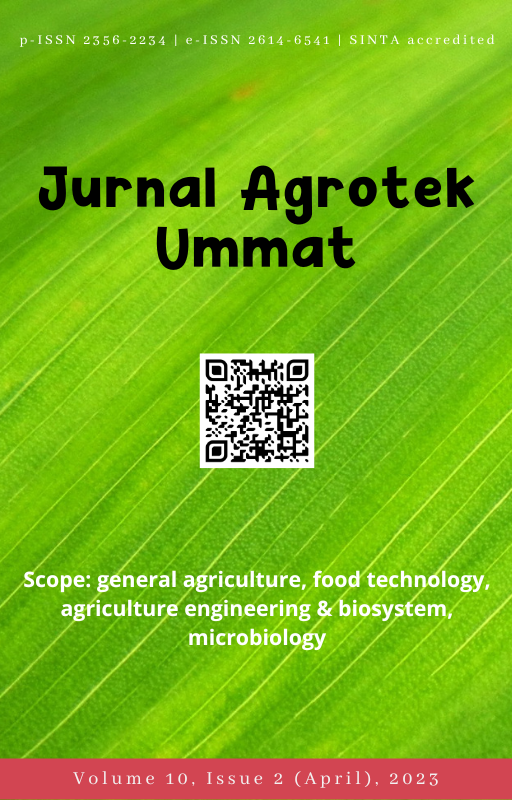Study of dissolved oxygen quality response in smart watering and autopot systems due to the effect of changes in environmental temperature
DOI:
https://doi.org/10.31764/jau.v10i2.13347Keywords:
Autopot, Hidroponik, Kadar Oksigen Terlarut, Smart Watering Unpad, Suhu LingkunganAbstract
Hydroponics is an agricultural farming system that does not use soil media but uses water media containing nutrient solutions. The purpose of this research is to measure and observe dissolved oxygen levels in the Smart Watering Unpad and Autopot Systems that have never been done before. The research was conducted using descriptive analysis method that is measuring, observing, calculating, and analysing quantitative data on hydroponic installations Smart Watering Unpad and Autopot. The fertigation used in this study were Smart Watering Unpad and Autopot with the parameters observed were ambient temperature, dissolved oxygen, and the relationship between ambient temperature and Dissolved Oxygen for 30 days of observation. The results showed that the response of dissolved oxygen levels was influenced by environmental temperature in the SWU 01 Lettuce, SWU 02, SWU 03, and SWU 01 Paprika systems had a NEGATIVE relationship direction. The Autopot system is the only installation that has a POSITIVE change in the relationship of dissolved oxygen levels influenced by ambient temperature. Autopot is a hydroponic installation that can maintain the availability of dissolved oxygen levels in the nutrient solution. The Smart Watering Unpad 02 installation can maintain the availability of dissolved oxygen levels in the nutrient solution compared to other installations in the Smart Watering Unpad system type.
References
Affan, M., WAJIMA, T., & YASUTAKE, D. (2005). High Temperature Effect on Root Absorption. Agric Meteorol, 60(5), 809–812.
Arip, M., & Thoriq, D. A. (2022). Kelayakan Budidaya Selada Krop Dengan Sistem Smart Watering Di Greenhouse Ftip Unpad Feasibility Of Cultivation Of Crop Lettuce With Smart Watering System At Greenhouse Ftip Unpad. Jurnal Agriekstensia, 21(1).
Bafdal, N., Dwiratna, S., & Kendarto, D. R. (2017). Impact of water use on paprika (Capsicum annum) by using fertigation and autopot system combined with numerous growing media. Asian Journal of Plant Sciences, 16(3), 149–159.
Dwiratna, S., Amaru, K., & Nanda, M. A. (2022). The Potential of Hydroponic Kit-Based Growing on a Self-Fertigation System for Pagoda Mustard (Brassica narinosa L) Production. Scientific World Journal, 2022. https://doi.org/10.1155/2022/1984297
Fauzi, R., Tarwaca, E., Putra, S., & Ambarwati, D. E. (2013). Pengayaan Oksigen Di Zona Perakaran Untuk Meningkatkan Pertumbuhan Dan Hasil Selada (Lactuca Sativa L.) Secara Hidroponik Oxygen Enrichment In The Root Zone To Increase The Growth And Yield Of Hydroponics Lettuce (Lactuca Sativa L.). Jurnal Vegetalika, 2(4), 63–74.
Hali, A. S., S Bani, M. D., & Nitit, B. P. (2021). Efisiensi Penerapan Metode Fuzzy Logic Pada Hidroponik Sistem Nutrient Film Technique. Jurnal Gatra Nusantara, 19(2), 208–211.
Harpenas, A., & Dermawan, R. (2010). Budi daya cabai unggul. PT Niaga Swadaya.
Hidayah, A. L., Dwiratna, S., Prawiranegara, B. M. P., & Amaru, K. (2020). Kinerja dan Karakteristik Konsumsi Energi, Air, dan Nutrisi pada Sawi Pagoda (Brassica narinosa) Menggunakan Sistem Fertigasi Deep Flow Technique (DFT). Jurnal Keteknikan Pertanian Tropis Dan Biosistem, 8(2), 125–134. https://doi.org/10.21776/ub.jkptb.2020.008.02.02
Krisna, B., Tarwaca Susila Putra, E., Rogomulyo, R., & Kastono, D. (2017). Pengaruh Pengayaan Oksigen dan Kalsium terhadap Pertumbuhan Akar dan Hasil Selada Keriting (Lactuca sativa L.) pada Hidroponik Rakit Apung The Effects of Oxygen and Calcium Enrichment on the Root Growth and Yield of Curly Lettuce (Lactuca sativa L.) that . Jurnal Vegetalika, 6(4), 14–27.
Mahlangu, R. I. S., Maboko, M. M., Sivakumar, D., Soundy, P., & Jifon, J. (2016). Lettuce (Lactuca sativa L.) growth, yield and quality response to nitrogen fertilization in a non-circulating hydroponic system. Journal of Plant Nutrition, 39(12), 1766–1775.
Mardaus, Sari, I., & Yusuf, E. Y. (2019). Produksi Tanaman Tomat (Solanum Lycopersicum L.) Dengan Pemberian Sp-36 Dan Dolomit Di Tanah Gambut. Jurnal AGROINDRAGIRI, 4(2).
PT.Hiup. (2022). Katalog Smart Watering Unpad. In PT. Hiup Indonesia.
Reza, P. M. A., Syuhriatin, & Rahayu, S. M. (2021). Analisis Pertumbuhan Tanaman Paprika (Capsicum Annuum Var. Grossum) Berdasarkan Pola Tanam. Lombok. Lombok Journal of Science, 3(1), 23–32.
Savitri, D. A., Nadzirah, R., & Novijanto, N. (2020). Pelatihan Hidroponik Sistem DFT Guna Mmenumbuhkan Jiwa Kewirausahaan Siswa di Jember. Jurnal Masyarakat Mandiri Ummat, 4(5), 969–977. https://doi.org/10.31764/jmm.v4i5.3112
Siregar, J. (2015). Pengujian Beberapa Nutrisi Hidroponik Pada Selada (Lactuca Sativa L.) Dengan Teknologi Hidroponik Sistem Terapung (Thst) Termodifikasi. UNIVERSITAS LAMPUNG.
Subiyanto, E. R. B. (2019). Budidaya Hidroponik Tanaman Selada Romaine (Lactuca Sativa L. Var. Longifolia) Dengan Pemberian Berbagai Pupuk Organik Cair. DHAYANA PURA.
Sugiyono. (2007). Statistik untuk Penelitian (E. Mulyariningsih (ed.); 12th ed.). ALFABETA BANDUNG.
Downloads
Published
Issue
Section
License
Authors who publish articles in Jurnal Agrotek Ummatagree to the following terms:- Authors retain copyright of the article and grant the journal right of first publication with the work simultaneously licensed under a CC-BY-SA or The Creative Commons Attribution–ShareAlike License.
- Authors are able to enter into separate, additional contractual arrangements for the non-exclusive distribution of the journal's published version of the work (e.g., post it to an institutional repository or publish it in a book), with an acknowledgment of its initial publication in this journal.
- Authors are permitted and encouraged to post their work online (e.g., in institutional repositories or on their website) prior to and during the submission process, as it can lead to productive exchanges, as well as earlier and greater citation of published work (See The Effect of Open Access).

